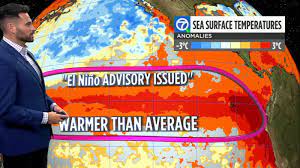
Officially, El Nino is under way
Experts predict that when El Nio intensifies, the warming of the Pacific Ocean will continue. This implies a greater impact on global weather patterns.El Nio has finally materialised after months of speculation, and it will play a significant role in determining global weather patterns until 2024.
El Nio conditions are existing and are anticipated to progressively develop throughout the Northern Hemisphere during the winter of 2023–2024, according to a statement released by NOAA’s Climate Prediction Centre on Thursday morning. When ocean temperatures near the equator are at least 0.9 degrees Fahrenheit (0.5 degrees Celsius) above the historical average for a three-month period, El Nio is a frequent climatic phenomena in the eastern Pacific Ocean. The prolonged warm spell in this oceanic region affects the jet stream and the general weather patterns in North America. El Nio last appeared in the years from.
El Nio’s potential development was discussed by Senior Meteorologist and Long-Range Specialist Paul Pastelok during the release of AccuWeather’s annual spring forecast for the United States in February. This prediction has been made by AccuWeather forecasters for months.This is a dramatic contrast to the previous three years, when La Nia, El Nio’s colder counterpart, ruled the Pacific Ocean.Weather implications of El Nino
El Nio can aid in reducing tropical activity in the Atlantic Ocean throughout the summer and fall. This is one aspect that AccuWeather’s long-range forecasters took into account when releasing their prediction for the 2023 Atlantic hurricane season. Typically, a more vigorous storm track farther south through an El Nio pattern.
El Nio has only just begun to manifest. By the end of 2023 or the beginning of 2024, there is an 84% likelihood, according to NOAA, that it will strengthen to at least moderate strength, having a greater impact on global weather patterns. It is expected to become stronger than the last previous El Nio, which occurred four years ago. The winter of 2015–16 saw the development of the strongest El Nio on record, narrowly defeating the one that took place in the winter of 1997–98.
